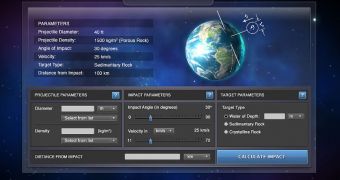Officials at the Purdue University announce the opening of a new online tool called “Impact: Earth,” which can be accessed by everyone, and that can model the potential consequences of an asteroid or comet hitting our planet.
The new website allows for the input of various parameters for each scenario, which makes it suitable for use by governmental agencies and the American space agency.
Still, it has enough visual appeal to capture the imagination of children and teenagers as well, and is very user-friendly. The simple and intuitive interface is bound to make it a success, experts at the university believe.
The new site was opened today, November 3, and can already be accessed online. The design of the impact effects calculator was led by Purdue distinguished professor of earth and atmospheric sciences and physics Jay Melosh.
This tool is bound to capture the attention of many people due to the fact that the world is slowly beginning to become aware of the fact that in excess of 100 tons of asteroid and comet materials reach Earth each single day.
Several times each year, pieces of space rock the size of a car enter the atmosphere, but luckily most of them burn up in the upper atmosphere as shooting stars, and cause no damage.
“'The site is intended for a broad global audience because an impact is an inevitable aspect of life on this planet and literally everyone on Earth should be interested,” Melosh explains.
“'There have been big impacts in the past, and we expect big impacts in the future. This site gives the lowdown on what happens when such an impact occurs,” adds the expert, who also specializes in impact cratering studies.
When first using the site, visitors are asked to input some data, such as the diameter of the potential impactor, its density, velocity, angle of entry and impact location.
The program then processes these data, and gives back data such as how debris will be distributed, what type of earthquakes would form and how long it would take for them to strike, as well as info on what type of crater would be produced.
“Fairly large events happen about once a century. The biggest threat in our near future is the asteroid Apophis, which has a small chance of striking the Earth in 2036,” the expert says.
“It is about one-third of a mile in diameter, and the calculator will tell what will happen if it should fall in your backyard,” Melosh concludes.
You can visit the Purdue impact calculator here.

 14 DAY TRIAL //
14 DAY TRIAL //